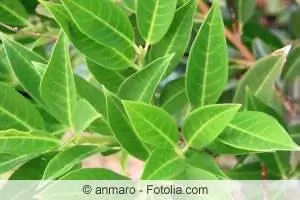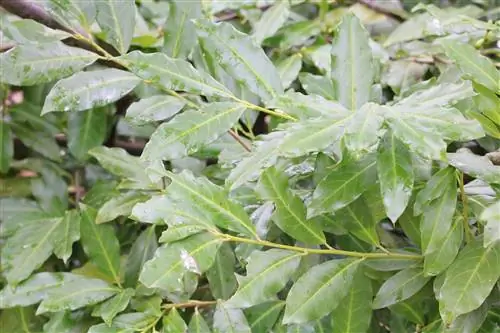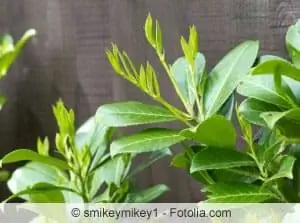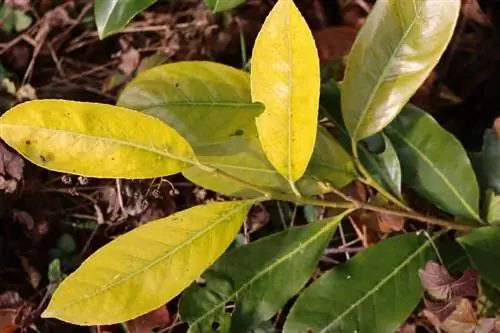- Author admin [email protected].
- Public 2023-12-17 03:39.
- Last modified 2025-01-24 12:45.
Cherry laurel is an evergreen plant that does not shed its dark green foliage even in winter. Prunus laurocerasus is considered extremely robust and can be used in a variety of ways in the garden. Ornamental trees often have brown leaves in spring, which understandably causes many hobby gardeners to despair. But contrary to what is often assumed, the wilted leaves are not due to a fungal pathogen or a disease. Frost or drought are much more likely to cause the brown leaves. You can protect your plants from this to a limited extent using simple means.
Popular hedge and solitary plant
Cherry laurel is a popular hedge plant due to its fast and dense growth. Within a short time, the tree seals off the garden from prying eyes from outside. This protection is not lost even in winter, because the plant, which belongs to the rose family, has evergreen foliage. Because of the laurel-like leaves, the plant was given the German name “laurel cherry” or “cherry laurel”. However, we strongly advise against consuming the stone fruits or other parts of the plant. In 2013, Prunus laurocerasus, syn.: Laurocerasus officinalis, was named poisonous plant of the year. Except for the shape of its leaves, cherry laurel itself has nothing to do with the real types of laurel.
There are well over 20 different cultivars and species of laurel cherries available from specialist retailers, which differ particularly in their height and speed of growth. But there are also differences when it comes to “frost hardiness”. While some of the evergreen species can only be cultivated without problems in regions with mild winters, others can cope even with double-digit and long-lasting temperatures below zero. If the needs and requirements of the respective cherry laurel species are not met or only inadequately met, the he alth and growth of the ornamental tree will suffer. Fungal pathogens, pests and other deficiency symptoms are also often the result. Many hobby gardeners complain that their once opaque cherry laurel hedge has an increasing number of brown leaves. With just a little effort you can restore your plants to their former glory.
Brown leaves on cherry laurel
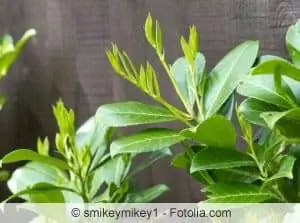
Evergreen trees are considered easy to care for and robust. However, the plants should never be left completely to their own devices, not even in the cold season. Brown leaves on ornamental trees often appear after a long or harsh winter and are often due to frost damage. But an inadequate supply of water can also cause brown leaves and discoloration. The symptoms are particularly severe from February onwards, when the sun's power slowly increases, but the roots of the plant cannot yet absorb water due to the frozen ground. The unsightly spots can be quickly removed in March and April:
- Short dead shoots down to living tissue.
- Carefully remove brown leaves.
- You can prune hard in the spring.
- Use only mechanical tools.
Don't use motorized garden or hedge trimmers. With this type of pruning, even he althy leaves suffer massive damage, and the external appearance of the ornamental tree suffers enormously. Brown leaves on cherry laurel are an unsightly side effect if the plants are cultivated incorrectly. Even if the dead leaves and shoots can be removed quickly, you should still get to the bottom of the cause.
Tip:
High-growing cherry laurel species can be shortened by up to 2/3. This also encourages the plant to produce bushy shoots.
The right care
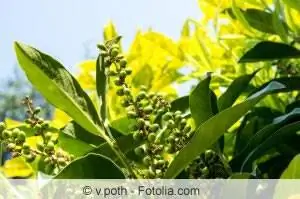
Brown leaves on evergreen ornamental trees are a nuisance, but rarely a cause for concern. However, in order not to always have to resort to scissors in the spring, you should take a few precautions. Some varieties of cherry laurel can easily endure -20°C without any noticeable damage to the plants. However, the interaction of sun, wind and frost poses a high risk for sensitive varieties. Avoid spontaneous purchases, because the cherry laurel species should not only meet your own requirements, but also easily suit the prevailing climatic conditions.
Winter-hardy varieties
- Prunus laurocerasus Caucasica: Reaches a height of up to 2.50 meters. Fast growing variety with an increase of around 50 centimeters per year.
- Prunus laurocerasus Cherry Brandy: Rather broad-growing cherry laurel species, reaches a maximum height of around 1 meter. The growth width varies between 2 and 3.5 meters.
- Prunus laurocerasus Herbergii: Popular, hardy variety. The height is about 3 meters.
Another way to get a robust variety of cherry laurel inexpensively: Take a walk around the neighborhood and keep your eyes peeled for older cherry laurel plants. You can tell by their external appearance whether the plants have problems with the climate. Ask for one or more cuttings from he althy ornamental trees. If possible, plant the plants in a location protected from the wind.
Preventive measures
Even hardy varieties of Prunus laurocerasus are not completely immune to brown leaves. Damage is usually caused by drought. Unlike deciduous plants, plants with evergreen foliage require a moderate supply of water all year round. Watering should be done on frost-free days, which is often a problem, especially in the cold season. Take precautions in the fall to enable watering in the winter:
- Loosen the soil sufficiently - even for hedge plants.
- Apply a 3 to 4 centimeter thick layer of bark mulch.
- Water the plants thoroughly before the first frost.
Compost is also good for protecting the soil from freezing. The material decomposes slowly and, in addition to producing heat, it also releases important nutrients into the soil. The cherry laurel uses this to sprout vigorously in early spring.
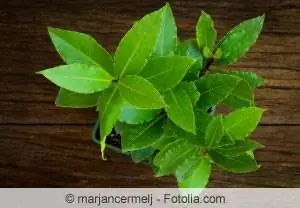
The best time to plant evergreen plants is in late summer or early autumn. You can also take precautionary measures to get the young trees safely through their first winter. Loosen the soil sufficiently and fill the planting hole with an approximately 10 centimeter thick layer of semi-ripe compost. Maintain a sufficient minimum distance between individual cherry laurel plants. Because then the plants do not compete with each other for water and nutrients. The evergreen plant may not be artificially fertilized between September and March. Even if the root ball must not dry out and regular watering is therefore necessary, the situation is different when it comes to minerals. In winter, the plants are not able to utilize the fertilizer optimally and damage to the above- and underground parts of the plant can occur.
Conclusion
Cherry laurel is a decorative plant that is extremely robust and easy to grow under the right location and care conditions. Despite all care and precautions, damage caused by dryness and cold is almost unavoidable, especially during a harsh winter. Even the frost-resistant types of cherry laurel suffer from it. Take precautions and reduce damage. Brown leaves on the laurel cherry can also be removed quickly and easily with scissors. Pruning incorrectly is almost impossible because bare spots on the plant are quickly hidden by the rapid growth of the ornamental tree.

